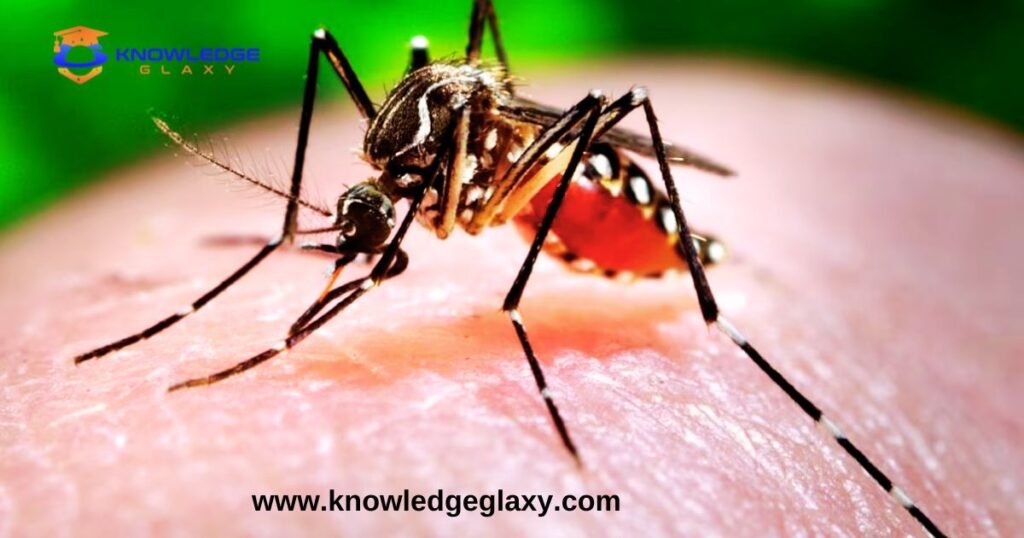Introduction
In Pakistan, dengue fever is a severe health risk that is transmitted by mosquitoes and is most prevalent during the monsoon season. The National Dengue Control Program (NDCP) plays a crucial role in coordinating efforts to mitigate its impact. This article delves into the program’s initiatives, the current dengue situation in Pakistan, and how you can protect yourself and your community.
Efforts Towards National Dengue Control in Pakistan
Dengue fever has become a critical public health concern in Pakistan over the last two decades. This mosquito-borne viral disease has increased dramatically nationwide, with recurrent seasonal outbreaks causing considerable morbidity and mortality. Comprehensive dengue control remains a challenging long-term goal, needing coordinated efforts between authorities and communities.
This article will overview the current national dengue surveillance and vector control strategies employed in Pakistan to combat widespread outbreaks.
Read More: World Cancer Day

Background of Dengue in Pakistan
Dengue virus first emerged in Pakistan in 1985 with a small localized outbreak. After this, a few sporadic outbreaks occurred. Then, dengue incidence rose steeply starting in 2010, with Pakistan reporting its most severe epidemic in 2011, affecting over 21,000 people.
Major risk factors assisting rapid dengue proliferation include increased global trade and travel, uncontrolled urbanization and crowds ideal for mosquito habitats, inadequate sanitation and waste disposal, climate change pressures, limited population immunity, and insufficient vector management.
Overall, the past decade has seen over 750,000 people affected across Pakistan, according to estimates. Dengue prevalence is highest in Sindh and Punjab provinces, especially the megacities Lahore and Karachi, which report 40-47% cases annually.
Dengue in Pakistan Today: Statistics and Trends
Dengue cases today: As of February 3, 2024, there is no readily available centralized data source for real-time dengue case updates in Pakistan. Knowledge Galaxy However, the National Institute of Health (NIH) publishes periodic updates on its website. National Dengue Control The most recent report, dated December 30, 2023, indicated 84,257 cases and 81 deaths in 2023.
Dengue in Lahore today: Similarly, specific data for Lahore’s current dengue situation might be limited. You can refer to the NIH website or local news sources for the latest updates in your area.
Dengue months in Pakistan: Usually, from July to November, during the monsoon season, dengue activity increases. But instances can happen at any time of year, particularly in warmer climates.
Understanding Dengue in Pakistan: History and Challenges
Dengue in Pakistan history: The first major dengue outbreak in Pakistan occurred in 1994, followed by several significant outbreaks in subsequent years. The increasing frequency and intensity of these outbreaks are attributed to various factors, including urbanization, inadequate sanitation, and climate change.
National Dengue Surveillance System: The National Dengue Surveillance System (NDSS) plays a vital role in tracking dengue activity across the country. It facilitates early detection, outbreak response, and resource allocation.
Current Challenges: Despite ongoing efforts, Pakistan faces numerous challenges in controlling dengue, including:
- Limited resources: The NDCP often needs more funding and personnel to implement control measures effectively.
- Inadequate public awareness: Many people need to gain knowledge about dengue prevention and early warning signs, hindering timely diagnosis and treatment.
- Poor sanitation: Stagnant water sources create breeding grounds for mosquitoes, posing a significant challenge in urban and rural areas alike.
- Climate change: The spread of dengue mosquitoes is facilitated by rising temperatures and erratic rainfall patterns.

Protecting Yourself and Your Community: Key Strategies
Individual measures:
- Mosquito bite prevention: Use insect repellent with DEET, cover up with long sleeves and pants, and use mosquito nets.
- Eliminate breeding grounds: Remove stagnant water from containers, tires, and other potential breeding sites around your home.
- Seek early medical attention: If you experience fever, headache, muscle aches, or other dengue symptoms, consult a doctor promptly.
Community-level initiatives:
- Public awareness campaigns: Educate communities about dengue prevention, early detection, and seeking medical care.
- Vector control activities: Implement fogging, larviciding, and other mosquito control measures in collaboration with local authorities.
- Improved sanitation: Advocate for and participate in initiatives to improve sanitation infrastructure and practices.
National Dengue Surveillance System
Considering escalating dengue cases, Pakistan’s Ministry of Health established a National Dengue Surveillance Cell in 2010 and a Dengue Expert Advisory Group in 2011 to facilitate surveillance coordination and outbreak responses.
Additionally, a national integrated dengue surveillance system collects data from District Health Authorities to monitor long-term trends nationwide. Information flows from health institutions to field epidemiologists, district authorities, provincial units, and finally, central analysis.
This data captures details like geographical spread, frequency, demographics affected, and deaths. It enables observing relative seasonality and high-risk areas for targeted prevention and control planning.
Current Status of Dengue in Pakistan
In 2022, over 37,425 dengue cases and 92 related deaths occurred countrywide. National Dengue Control Comparatively, 2019 saw 50,161 cases, while 2020 reported 23,849 during COVID-19 pressures on health infrastructure limiting outbreak responses.
The 2022 data until December shows the seasonal caseload peaking in October across Pakistan after the post-monsoon period, fostering ample mosquito breeding grounds.
The majority of cases occurred in Sindh at 22,964, followed by Punjab at 10,711. Karachi and Lahore saw 11,540 and 8,342 cases, respectively. Islamabad’s capital area saw 3025 instances. September-November remain peak months historically for dengue incidence in Pakistan’s tropical climate.
When Will The Dengue Season End in Pakistan?
Dengue transmission season in Pakistan generally spans the warmer monsoon months between September to November. National Dengue Control Cases begin rising in August, hit a peak in October, and start declining by December as temperatures cool.
By January to March, viral transmission tapers off across most regions of the country. However, warmer city areas and southern coastal regions maintain breeding cycles that enable a few sporadic cases even in cooler months.
Overall, December through February represent minimal transmission periods before the cycle begins again post-March. National Dengue Control Disease surveillance data over the past decade clearly maps out this seasonal dengue pattern in Pakistan.
Authorities hope ongoing control measures will help flatten incidence curves and shorten high transmission periods in coming years.
Current Control and Prevention Strategies
Pakistan aims for comprehensive, integrated vector management by synergizing chemical, biological, and educational tactics.
Key initiatives include:
- Larvicidal spraying of water bodies using temephos
- Space spraying pyrethroid insecticides
- Distributing larvicide chemicals and cleaning agents
- Fish introduction in water reservoirs
- Promoting protective clothing, nets, and repellents
- Awareness campaigns for community participation
- Establishing improved disease monitoring and reporting
The Dengue Expert Advisory Group routinely advises updating diagnostics, treatment protocols, and surveillance systems per evolving epidemiology.
Future Outlook for Dengue Control in Pakistan
Several challenges continue to hamper effective containment: lack of modern infrastructure, resource limitations, insufficient technical expertise, unchecked urbanization, climate stresses, and slow vaccine access.
Controlled trials of the new Dengvaxia vaccine are underway to determine suitability for future immunization programs. National Dengue Control Meanwhile, SangVax is another vaccine undergoing development and testing.
Advanced molecular research on viral serotypes, genomic epidemiology, diagnostic markers, mosquito Wolbachia manipulation, microbial larvicides, native plant extracts, and nanotechnology also offer promising options.
Authorities are optimistic that elevating available funding, improving environmental hygiene practices through legislation, upgrading healthcare capacity, and sustaining community partnerships will make National Dengue Control prevention National Dengue Control goals achievable in the long run.
Conclusion
National Dengue Control in Pakistan requires a multi-pronged approach involving individuals, communities, and healthcare authorities. National Dengue Control Through collaboration, we can lessen the effects of this potentially fatal illness and build a more robust future for all.

Read More: National Dengue Control
FAQs
What is the National Dengue Control Program (NDCP)?
The National Dengue Control Program (NDCP) is a crucial initiative spearheaded by Pakistan’s government to combat the threat of dengue fever. Established in 2004, the program works at a national level to coordinate and implement strategies for:
Dengue prevention: Through public awareness campaigns, vector control activities, and environmental management initiatives.
Early detection and diagnosis: By strengthening surveillance systems, promoting timely diagnosis, and ensuring access to healthcare facilities.
Case management and treatment: By providing standardized treatment protocols, improving healthcare provider training, and ensuring adequate medical supplies.
Outbreak response: By rapidly deploying resources and implementing effective control measures in areas experiencing dengue outbreaks.
The NDCP operates through a network of provincial and district-level units, ensuring a localized approach to address specific needs and challenges in different regions of Pakistan.
What is the National Action Plan for Dengue?
The National Action Plan for Dengue serves as a roadmap for the NDCP’s activities. It is a comprehensive document outlining:
Current situation: Analyzing the prevalence, distribution, and risk factors associated with dengue in Pakistan.
Strategic objectives: Defining clear goals for reducing dengue cases, mortality rates, and the overall burden of the disease.
Implementation strategies: Specifying concrete actions across various areas, including vector control, case management, public awareness, and research.
Monitoring and evaluation: Establishing mechanisms to track progress, measure impact, and identify areas for improvement.
The National Action Plan is periodically reviewed and updated to reflect the evolving situation and ensure the effectiveness of the NDCP’s respons
What are the objectives of the National Dengue Control Unit (NDCU)?
The National Dengue Control Unit (NDCU) serves as the focal point for the NDCP within the Ministry of Health. Its key objectives include:
Coordinating: Collaborating with various stakeholders, including provincial and district health authorities, academic institutions, NGOs, and communities, to ensure aligned and effective dengue control efforts.
Surveillance: Establish and maintain a robust dengue surveillance system to track disease trends, identify outbreaks early, and inform decision-making.
Technical guidance: Providing technical expertise and support to healthcare professionals, vector control specialists, and program implementers at various levels.
Resource mobilization: Advocating for and securing funding, personnel, and other resources required for effective dengue control programs.
Monitoring and evaluation: keeping an eye on the NDCP’s implementation, assessing its effects, and pinpointing areas in need of improvement.
The NDCU plays a vital role in leading and coordinating the national response to dengue fever in Pakistan.
What are the methods of controlling dengue?
Dengue control requires a multi-pronged approach, focusing on both preventing mosquito bites and controlling mosquito populations. Here are some essential methods:
Individual level:
Mosquito bite prevention: Using mosquito nets, wearing long-sleeved clothing, and applying insect repellent containing DEET.
Eliminating breeding grounds: Removing stagnant water from containers, tires, and other potential mosquito breeding sites around homes and communities.
Community level:
Vector control activities: Implementing fogging, larviciding, and other mosquito control measures in collaboration with local authorities.
Improved sanitation: Advocating for and participating in initiatives to improve sanitation infrastructure and practices, reducing mosquito breeding grounds.
Public awareness campaigns: Educating communities about dengue prevention, early detection, and seeking prompt medical attention.
National level:
Surveillance and early warning systems: Tracking dengue activity, identifying outbreaks early, and mobilizing resources for timely response.
Strengthening healthcare systems: Ensuring access to diagnostic tests, effective treatment protocols, and trained healthcare professionals.
Research and development: Investing in research on dengue vaccines, improved diagnostics, and new vector control methods.
By implementing a combination of these methods at different levels, we can significantly reduce the burden of dengue fever in Pakistan.
What are the 7 warning signs of dengue?
National Dengue Control can progress rapidly, so recognizing early warning signs is crucial. Here are 7 important indicators:
Sudden high fever: frequently falling between 38.9°C and 40.6°F (102°F to 105°F).
Severe headache: Often described as a throbbing pain behind the eyes.
Muscle and joint pain: Intense pain, sometimes described as feeling like your bones are breaking.
Nausea and vomiting May be persistent and severe.
Loss of appetite: Feeling little or no desire to eat.
Skin rash: May appear 2-3 days after the fever starts, often with a flushed face and red spots on the arms and legs.






